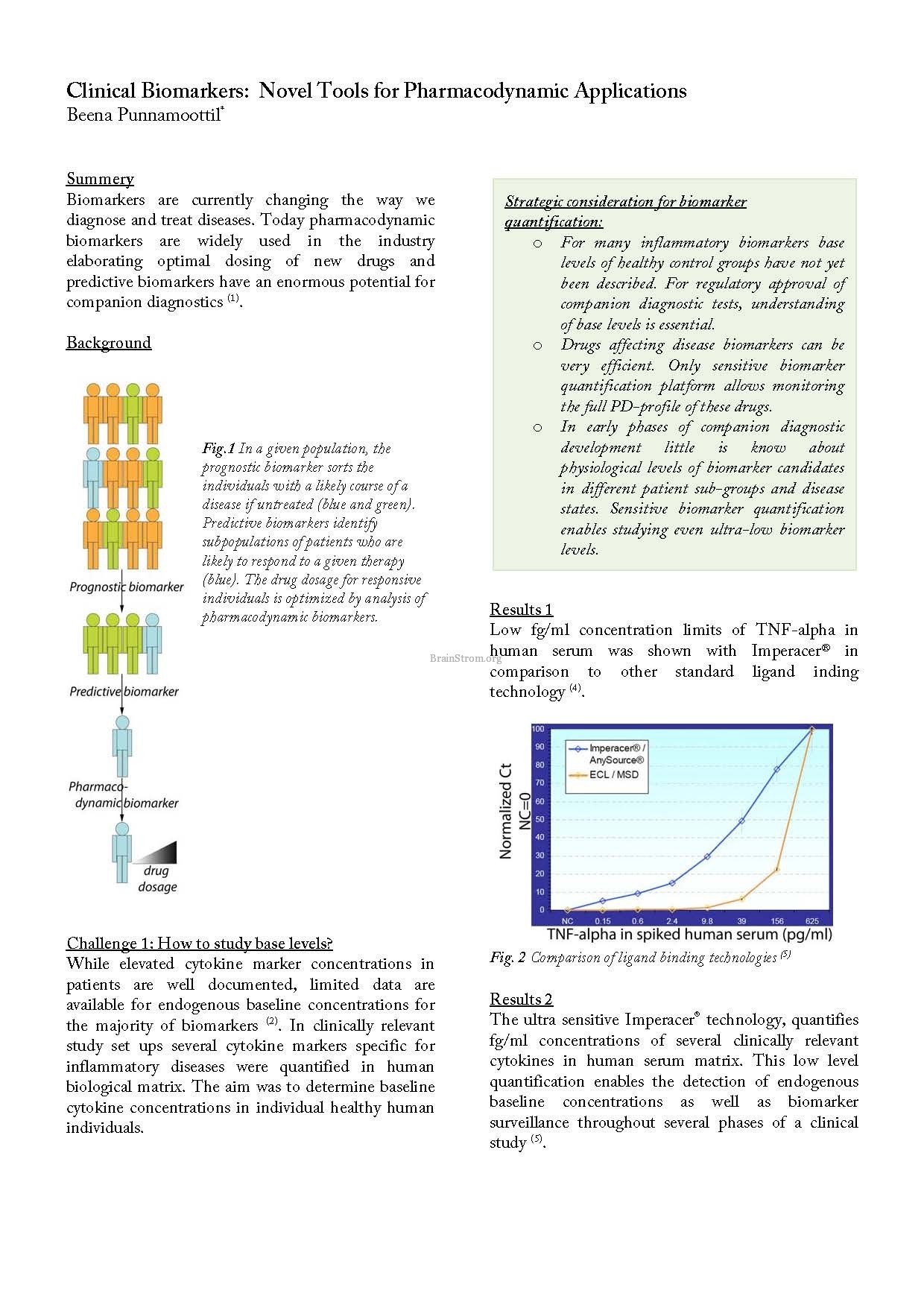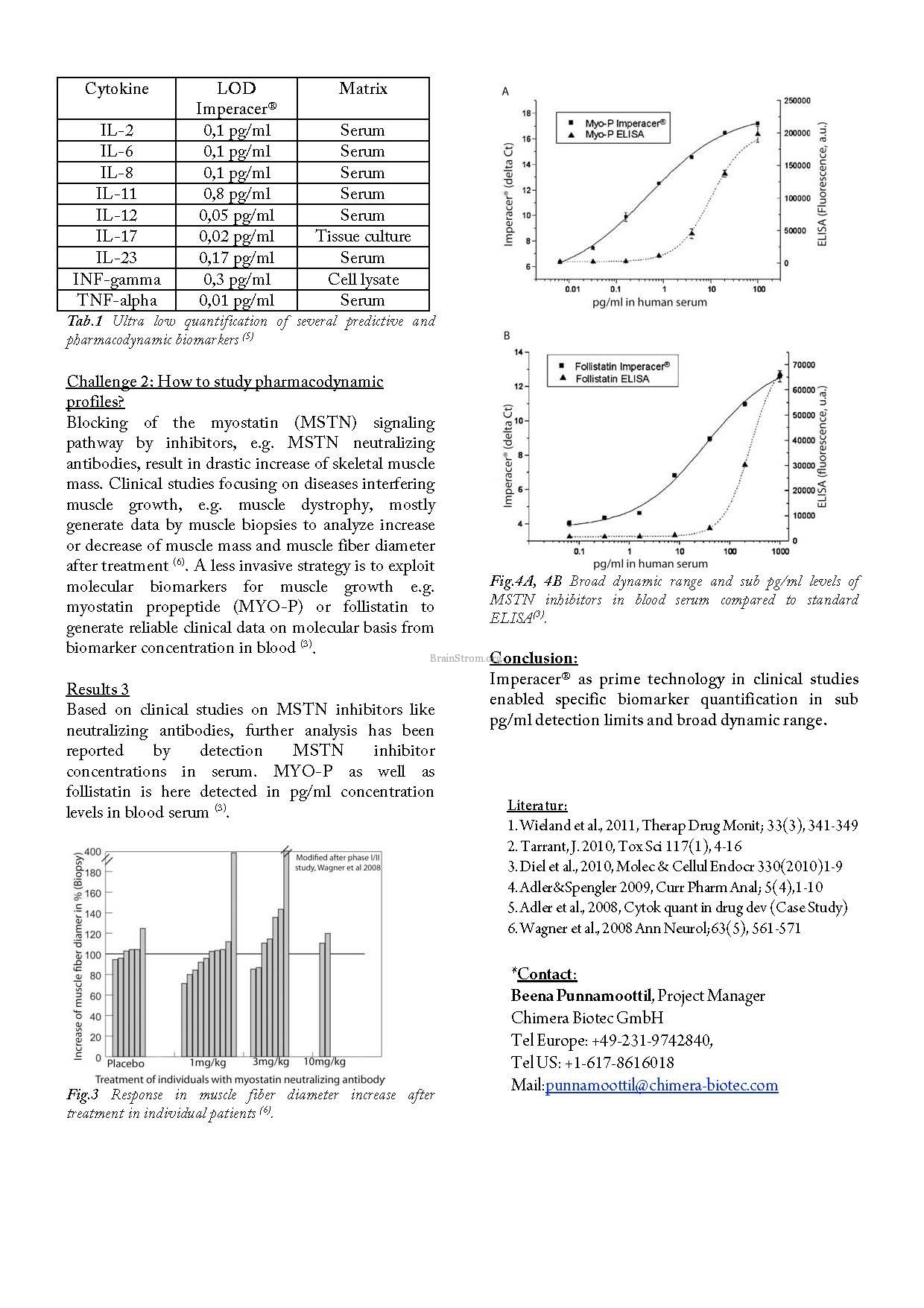Beena Punnamoottil*
Summery
Biomarkers are currently changing the way we diagnose and treat diseases. Today pharmacodynamic biomarkers are widely used in the industry elaborating optimal dosing of new drugs and predictive biomarkers have an enormous potential for companion diagnostics (1).



Background
Fig.1 In a given population, the prognostic biomarker sorts the individuals with a likely course of a disease if untreated (blue and green). Predictive biomarkers identify subpopulations of patients who are likely to respond to a given therapy (blue). The drug dosage for responsive individuals is optimized by analysis of pharmacodynamic biomarkers.
Strategic consideration for biomarker quantification:
o For many inflammatory biomarkers base levels of healthy control groups have not yet been described. For regulatory approval of companion diagnostic tests, understanding of base levels is essential.
o Drugs affecting disease biomarkers can be very efficient. Only sensitive biomarker quantification platform allows monitoring the full PD-profile of these drugs.
o In early phases of companion diagnostic development little is know about physiological levels of biomarker candidates in different patient sub-groups and disease states. Sensitive biomarker quantification enables studying even ultra-low biomarker levels.
Results 1
Low fg/ml concentration limits of TNF-alpha in human serum was shown with Imperacer® in comparison to other standard ligand inding technology (4).
Challenge 1: How to study base levels?
While elevated cytokine marker concentrations in patients are well documented, limited data are available for endogenous baseline concentrations for



Fig. 2 Comparison of ligand binding technologies
Results 2
(5)
the majority of biomarkers (2). In clinically relevant study set ups several cytokine markers specific for inflammatory diseases were quantified in human biological matrix. The aim was to determine baseline cytokine concentrations in individual healthy human individuals.
The ultra sensitive Imperacer® technology, quantifies
fg/ml concentrations of several clinically relevant
cytokines in human serum matrix. This low level
quantification enables the detection of endogenous
baseline concentrations as well as biomarker
surveillance throughout several phases of a clinical
study (5).
| Cytokine | LOD Imperacer® | Matrix |
| IL-2 | 0,1 pg/ml | Serum |
| IL-6 | 0,1 pg/ml | Serum |
| IL-8 | 0,1 pg/ml | Serum |
| IL-11 | 0,8 pg/ml | Serum |
| IL-12 | 0,05 pg/ml | Serum |
| IL-17 | 0,02 pg/ml | Tissue culture |
| IL-23 | 0,17 pg/ml | Serum |
| INF-gamma | 0,3 pg/ml | Cell lysate |
| TNF-alpha | 0,01 pg/ml | Serum |
Tab.1 Ultra low quantification of several predictive and pharmacodynamic biomarkers (5)
Challenge 2: How to study pharmacodynamic profiles?
Blocking of the myostatin (MSTN) signaling pathway by inhibitors, e.g. MSTN neutralizing antibodies, result in drastic increase of skeletal muscle mass. Clinical studies focusing on diseases interfering muscle growth, e.g. muscle dystrophy, mostly generate data by muscle biopsies to analyze increase or decrease of muscle mass and muscle fiber diameter after treatment (6). A less invasive strategy is to exploit molecular biomarkers for muscle growth e.g. myostatin propeptide (MYO-P) or follistatin to generate reliable clinical data on molecular basis from biomarker concentration in blood (3).
Results 3
Based on clinical studies on MSTN inhibitors like neutralizing antibodies, further analysis has been reported by detection MSTN inhibitor concentrations in serum. MYO-P as well as follistatin is here detected in pg/ml concentration levels in blood serum (3).



Fig.3 Response in muscle fiber diameter increase after treatment in individual patients (6).
Fig.4A, 4B Broad dynamic range and sub pg/ml levels of MSTN inhibitors in blood serum compared to standard ELISA(3).
Conclusion:
Imperacer® as prime technology in clinical studies enabled specific biomarker quantification in sub pg/ml detection limits and broad dynamic range.
Literatur:
1. Wieland et al., 2011, Therap Drug Monit; 33(3), 341-349
2. Tarrant, J. 2010, Tox Sci 117(1), 4-16
3. Diel et al., 2010, Molec & Cellul Endocr 330(2010)1-9
4. Adler&Spengler 2009, Curr Pharm Anal; 5(4),1-10
5. Adler et al., 2008, Cytok quant in drug dev (Case Study)
6. Wagner et al., 2008 Ann Neurol;63(5), 561-571
*Contact:
Beena Punnamoottil, Project Manager
Chimera Biotec GmbH
Tel Europe: +49-231-9742840, Tel US: +1-617-8616018
Download free pdf from http://www.genengnews.com/application-notes/clinical-biomarkers-novel-tools-for-pharmacodynamic-applications/15/
Thanks for installing the Bottom of every post plugin by Corey Salzano. Contact me if you need custom WordPress plugins or website design.





You must log in to post a comment.